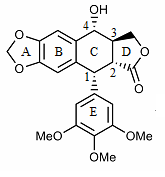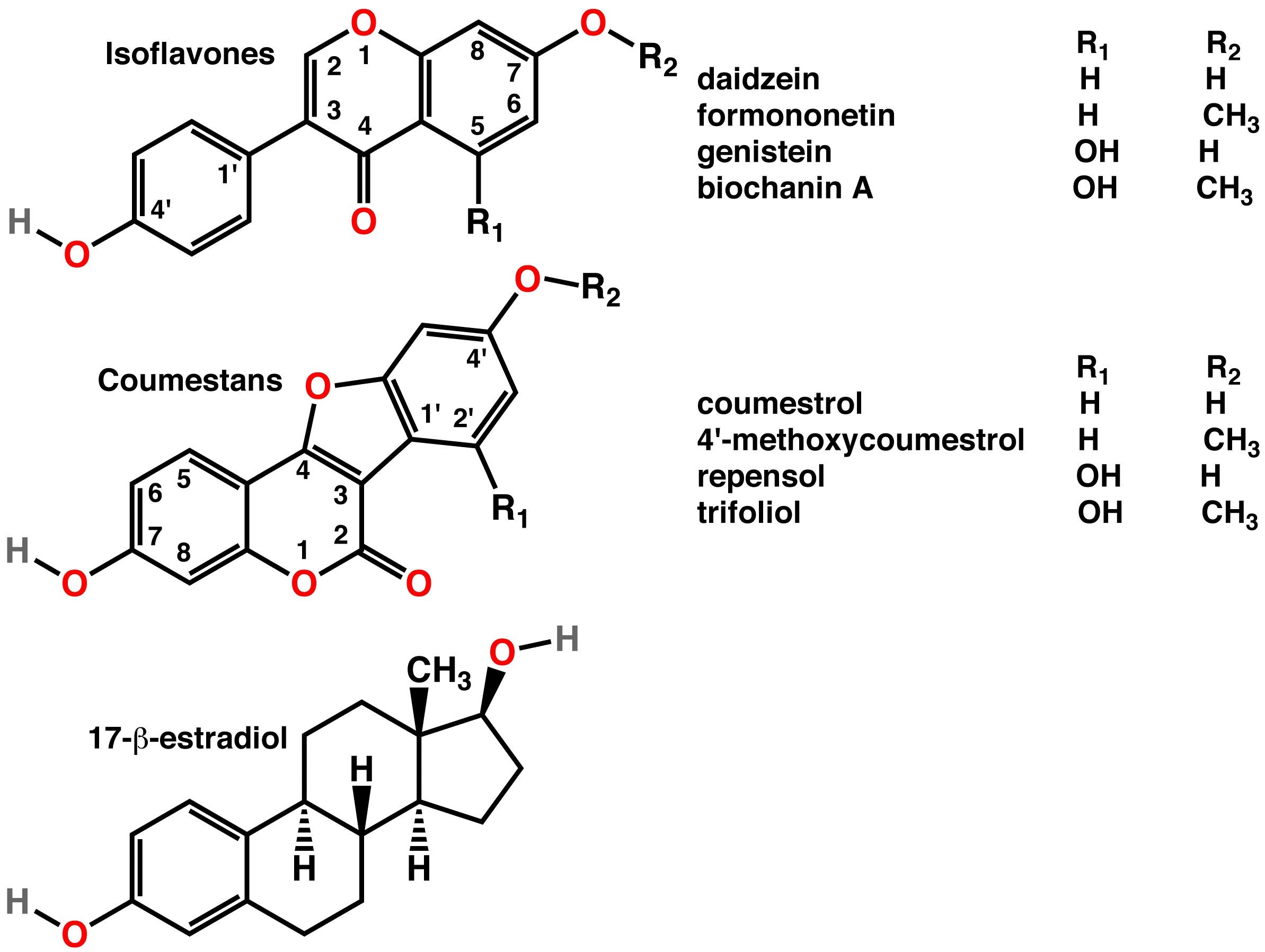|
Lignan
The lignans are a large group of low molecular weight polyphenols found in plants, particularly seeds, whole grains, and vegetables. The name derives from the Latin word for "wood". Lignans are precursors to phytoestrogens. They may play a role as antifeedants in the defense of seeds and plants against herbivores. Biosynthesis and metabolism Lignans and lignin differ in their molecular weight, the former being small and soluble in water, the latter being high polymers that are undigestable. Both are polyphenolic substances derived by oxidative coupling of monolignols. Thus, most lignans feature a C18 cores, resulting from the dimerization of C9 precursors. The coupling of the lignols occurs at C8. Eight classes of lignans are: "furofuran, furan, dibenzylbutane, dibenzylbutyrolactone, aryltetralin, arylnaphthalene, dibenzocyclooctadiene, and dibenzylbutyrolactol." Many lignans are metabolized by mammalian gut microflora, producing so-called enterolignans. Food sources Flax ... [...More Info...] [...Related Items...] OR: [Wikipedia] [Google] [Baidu] |
Enterolignan
Enterolignans are organic compounds formed by the action of gut microflora on lignan The lignans are a large group of low molecular weight polyphenols found in plants, particularly seeds, whole grains, and vegetables. The name derives from the Latin word for "wood". Lignans are precursors to phytoestrogens. They may play a role ...s. They are thus the products of the combined action of both plants and of the animal gut. Prominent enterolignans are enterodiol and enterolactone. Enterolignans are also called "mammalian lignans", although that term is self-contradictory since mammals do not produce lignans. . Enterolignans have attracted intense attention because of their potential beneficial roles in nutrition. Elevated levels of enterodiol in urine are attributed consumption of tea and other lignan-rich foods. References Polyols Lignans Phenols {{aromatic-stub ... [...More Info...] [...Related Items...] OR: [Wikipedia] [Google] [Baidu] |
Matairesinol
Matairesinol is an organic compound. It is classified as a lignan, i.e., a type of phenylpropanoid. It is present in some cereals, e.g. rye, and together with Secoisolariciresinol, has attracted much attention for its beneficial nutritional effects. Metabolism The plant lignans are precursors of the enterolignans (mammalian lignans). A number of plant lignans are metabolized to the enterolignans (enterodiol and enterolactone) that can potentially reduce the risk of certain cancers and cardiovascular diseases. Biomedical considerations Although some studies attribute disease preventative (cardio-protective and hormone associated cancers like breast cancer) benefits of lignans, the results are inconclusive. Matairesinol has been found to act as an agonist of the adiponectin receptor 1 Adiponectin receptor 1 (AdipoR1) is a protein which in humans is encoded by the ''ADIPOR1'' gene. It is a member of the progestin and adipoQ receptor (PAQR) family, and is also known as PAQR1. ... [...More Info...] [...Related Items...] OR: [Wikipedia] [Google] [Baidu] |
Pinoresinol
Pinoresinol is a tetrahydrofuran lignan found in ''Styrax sp.'', ''Forsythia suspensa, and in Forsythia koreana''. It is also found in the caterpillar of the cabbage butterfly, ''Pieris rapae'' where it serves as a defence against ants. In food, it is found in sesame seed, in ''Brassica'' vegetables and in olive oil. Pinoresinol has also been found to be toxic to larvae of the milkweed bug Oncopeltus fasciatus and of the haematophagous insect Rhodnius prolixus, which is a vector of chagas disease. Currently, pinoresinol is isolated from plants with low efficiency and low yield. Biosynthesis A first dirigent protein was discovered in '' Forsythia intermedia''. This protein has been found to direct the stereoselective biosynthesis of (+)-pinoresinol from coniferyl alcohol monomers. Recently, a second, enantiocomplementary dirigent protein was identified in ''Arabidopsis thaliana'', which directs enantioselective synthesis of (-)-pinoresinol. Pharmacology Pinoresinol inhib ... [...More Info...] [...Related Items...] OR: [Wikipedia] [Google] [Baidu] |
Secoisolariciresinol Diglucoside
Secoisolariciresinol diglucoside (SDG) is an antioxidant phytoestrogen present in flax, sunflower, sesame, and pumpkin seeds. In food, it can be found in commercial breads containing flaxseed. It is a precursor of mammal lignans which are produced in the colon from chemicals in foods. Extraction Secoisolariciresinol diglucoside can be isolated from de-fatted (hexane extraction) flaxseed by extraction of the lignan polymer precursor with a water/acetone mixture, followed by acetone removal and alkaline hydrolysis. Studies on biological effects Secoisolariciresinol diglucoside slows the growth of human breast cancer in mice. Secoisolariciresinol diglucoside may different roles in people. For example, due to 400-500Da size limit for Blood–Brain Barrier permeability, in one assessment of a Grade IV histology group of adult patients diagnosed with malignant glioma, high intake of secoisolariciresinol (for highest tertile compared to lowest tertile, in all cases) was assoc ... [...More Info...] [...Related Items...] OR: [Wikipedia] [Google] [Baidu] |
Secoisolariciresinol
Secoisolariciresinol is an organic compound. It is classified as a lignan, i.e., a type of phenylpropanoid. It is present in some cereals, e.g. rye, and together with matairesinol, has attracted much attention for its beneficial nutritional effects. Occurrence The water extract of silver fir wood contains more than 5% of secoisolariciresinol. It is also present in nettle brew. Its content in flaxseed (Linum usitatıssimum) was found to be 0.3%, which is the highest known content in food. Biomedical aspects In the intestine the gut microflora can form secoisolariciresinol from the secoisolariciresinol diglucoside and it can then be further transformed into the enterolignan enterodiol. Epidemiological studies showed associations between secoisolariciresinol intake and decreased risk of cardiovascular disease are promising, but they are yet not well established, perhaps due to low lignan intakes in habitual Western diets. At the higher doses used in intervention studies, associat ... [...More Info...] [...Related Items...] OR: [Wikipedia] [Google] [Baidu] |
Steganacin
Steganacin is an dibenzocyclooctadiene lactone, an unusual type of lignan. It exhibits some antileukemic properties. It has been isolated from ''Steganotaenia araliacea ''Steganotaenia araliacea'' is a species of flowering plant in the family Apiaceae. It is found in Angola, Benin, Botswana, Cameroon, Democratic Republic of Congo, Ethiopia, Kenya, Mozambique, Namibia, Somalia, South Africa, Sudan, Tanzan ...''. (−)-Steganacin is the natural form. Notes Lignans Antineoplastic drugs Cancer treatments Benzodioxoles Heterocyclic compounds with 5 rings Acetate esters Methoxy compounds Lactones {{aromatic-stub ... [...More Info...] [...Related Items...] OR: [Wikipedia] [Google] [Baidu] |
Podophyllotoxin
Podophyllotoxin (PPT) is the active ingredient in Podofilox, which is a medical cream that is used to treat genital warts and molluscum contagiosum. It is not recommended in HPV infections without external warts. It can be applied either by a healthcare provider or the person themselves. It is a non-alkaloid toxin lignin extracted from the roots and rhizomes of ''Podophyllum'' species. A less refined form known as podophyllum resin is also available, but has greater side effects. Podophyllotoxin was first isolated in pure form in 1880 by Valerian Podwyssotzki (1818 – 28 January 1892), a Polish-Russian privatdozent at the University of Dorpat (now: Tartu, Estonia) and assistant at the Pharmacological Institute there. It is on the World Health Organization's List of Essential Medicines. Medical uses Podophyllotoxin possesses a large number of medical applications, as it is able to stop replication of both cellular and viral DNA by binding necessary enzymes. It can addit ... [...More Info...] [...Related Items...] OR: [Wikipedia] [Google] [Baidu] |
Soybean
The soybean, soy bean, or soya bean (''Glycine max'') is a species of legume native to East Asia, widely grown for its edible bean, which has numerous uses. Traditional unfermented food uses of soybeans include soy milk, from which tofu and tofu skin are made. Fermented soy foods include soy sauce, fermented bean paste, nattō, and tempeh. Fat-free (defatted) soybean meal is a significant and cheap source of protein for animal feeds and many packaged meals. For example, soybean products, such as textured vegetable protein (TVP), are ingredients in many meat and dairy substitutes. Soybeans contain significant amounts of phytic acid, dietary minerals and B vitamins. Soy vegetable oil, used in food and industrial applications, is another product of processing the soybean crop. Soybean is the most important protein source for feed farm animals (that in turn yields animal protein for human consumption). Etymology The word "soy" originated as a corruption of the Can ... [...More Info...] [...Related Items...] OR: [Wikipedia] [Google] [Baidu] |
Sesame Seed
Sesame ( or ; ''Sesamum indicum'') is a flowering plant in the genus '' Sesamum'', also called benne. Numerous wild relatives occur in Africa and a smaller number in India. It is widely naturalized in tropical regions around the world and is cultivated for its edible seeds, which grow in pods. World production in 2018 was , with Sudan, Myanmar, and India as the largest producers. Sesame seed is one of the oldest oilseed crops known, domesticated well over 3,000 years ago. ''Sesamum'' has many other species, most being wild and native to sub-Saharan Africa. ''S. indicum,'' the cultivated type, originated in India. It tolerates drought conditions well, growing where other crops fail. Sesame has one of the highest oil contents of any seed. With a rich, nutty flavor, it is a common ingredient in cuisines around the world. Like other foods, it can trigger allergic reactions in some people. Etymology The word "sesame" is from Latin ''sesamum'' and Greek σήσαμον : ''sēsamon ... [...More Info...] [...Related Items...] OR: [Wikipedia] [Google] [Baidu] |
Phytoestrogen
A phytoestrogen is a plant-derived xenoestrogen (see estrogen) not generated within the endocrine system, but consumed by eating plants or manufactured foods. Also called a "dietary estrogen", it is a diverse group of naturally occurring nonsteroidal plant compounds that, because of its structural similarity with estradiol (17-β-estradiol), have the ability to cause estrogenic or antiestrogenic effects. Phytoestrogens are not essential nutrients because their absence from the diet does not cause a disease, nor are they known to participate in any normal biological function. Common foods containing phytoestrogens are soy protein, beans, oats, barley, rice, coffee, apples, carrots (see Food Sources section below for bigger list). Its name comes from the Greek ''phyto'' ("plant") and ''estrogen'', the hormone which gives fertility to female mammals. The word "estrus" - Greek οίστρος - means " sexual desire", and "gene" - Greek γόνο - is "to generate". It has been ... [...More Info...] [...Related Items...] OR: [Wikipedia] [Google] [Baidu] |
Monolignol
Monolignols, also called lignols, are the source materials for biosynthesis of both lignans and lignin and consist mainly of paracoumaryl alcohol (H), coniferyl alcohol (G) and sinapyl alcohol (S). These monolignols differ in their degree of methoxilation of the aromatic ring. The monolignols are derived from the amino acid phenylalanine via the phenylpropanoid pathway involving various enzymes. Phenylalanine is first converted to paracoumaryl alcohol (H), which is subsequently elaborated to coniferyl alcohol (G) and sinapyl alcohol (S). This reaction happens in the cytosol, while the polymerization of the monolignols occurs in the apoplast to which the monolignols have to be transported to though the cell membrane. The monolignols have been found as monolignol-4-O-β-d-glucosides, which might be their major way of storage. Another theory for this conversion is that is improving the transportation of the monolignols. The polymerization consists of oxidative coupling reactions ... [...More Info...] [...Related Items...] OR: [Wikipedia] [Google] [Baidu] |
Justicidin A
Justicidin A is a organic compound isolated from '' Justicia procumbens''. It is classified as a lignan The lignans are a large group of low molecular weight polyphenols found in plants, particularly seeds, whole grains, and vegetables. The name derives from the Latin word for "wood". Lignans are precursors to phytoestrogens. They may play a role .... The compound may possess cytotoxic effects. References {{organic-compound-stub Lactones Benzodioxoles Phenol ethers Lignans ... [...More Info...] [...Related Items...] OR: [Wikipedia] [Google] [Baidu] |



